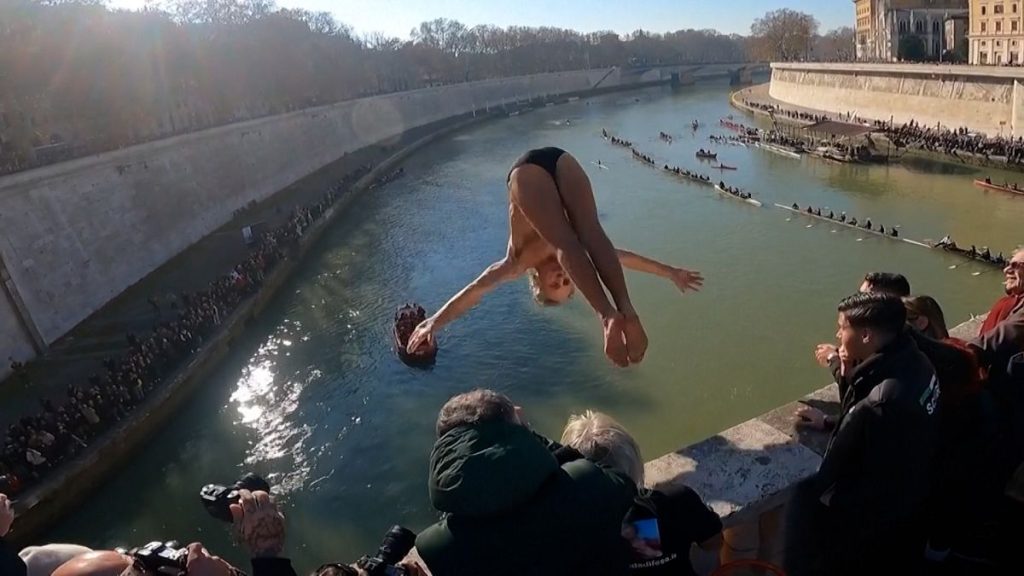The first day of 2025 witnessed the continuation of a time-honored tradition in Rome, Italy, as three daring individuals plunged from the 18-meter-high Cavour Bridge into the Tiber River below. This annual spectacle, inaugurated in 1946, has become a symbolic act of welcoming the new year, embodying a spirit of renewal and courage. This year’s event carried an added layer of significance as Maurizio Palmulli, affectionately known as “Mr. Ok,” performed his final dive, officially passing the torch to his successor, Marco Fois. Palmulli’s retirement marks the end of an era, leaving behind a legacy of fearless dives that have captivated onlookers for decades. The tradition, however, carries on, symbolizing the enduring human spirit of embracing challenges and celebrating new beginnings.
The Cavour Bridge dive represents a unique intersection of athleticism, spectacle, and cultural heritage. The divers, poised high above the flowing Tiber, embody a sense of daring and mastery over their physical prowess. The act itself is a fleeting moment, a graceful arc through the air before plunging into the water below. Yet, this brief spectacle holds profound meaning for both the divers and the spectators who gather to witness it. For the divers, it’s a test of nerve and skill, a personal triumph over gravity and fear. For the onlookers, it’s a shared experience of awe and excitement, a collective celebration of human bravery and the enduring power of tradition. The Cavour Bridge dive has thus become woven into the fabric of Rome’s cultural identity, a symbol of the city’s vibrant history and its embrace of the extraordinary.
In Berlin, Germany, a different kind of New Year’s Day tradition unfolded, equally steeped in symbolic meaning and communal spirit. Brave souls, undeterred by the frigid temperatures, participated in the annual ice bathing ritual, taking a plunge into the icy waters to welcome 2025. This act of submerging oneself in the cold represents a symbolic cleansing, a washing away of the past year and a welcoming of the new. The shared experience of enduring the icy embrace fosters a sense of camaraderie and collective resilience, a testament to the human capacity to overcome physical challenges and find joy in shared experiences.
The Berlin ice bathing tradition goes beyond a simple act of physical endurance; it’s a celebration of community and shared experience. Participants often gather beforehand, sharing warm drinks and conversation, building anticipation for the icy plunge. Once in the water, the atmosphere transforms into one of exhilaration and shared accomplishment. Shivering bodies move to the rhythm of music, and laughter echoes through the cold air. This shared experience of facing the cold together creates a powerful bond among participants, a testament to the human need for connection and shared experience, especially during times of celebration and renewal.
Both the Cavour Bridge dive in Rome and the ice bathing tradition in Berlin represent distinct cultural expressions of welcoming the new year. While one involves a dramatic display of physical prowess, the other emphasizes communal resilience and symbolic cleansing. Despite their differences, these traditions share a common thread: the human desire to mark significant moments with rituals and shared experiences. They symbolize the universal human impulse to embrace change, overcome challenges, and celebrate new beginnings. These traditions, passed down through generations, serve as vital links to the past, enriching the present and shaping the future.
The continuation of these traditions in 2025 underlines their enduring relevance in a rapidly changing world. In an era increasingly dominated by digital interactions and globalized culture, these localized traditions offer a sense of grounding and belonging. They provide a tangible connection to the past, reminding us of the enduring power of human rituals and the importance of community in celebrating shared values. The Cavour Bridge dive and the Berlin ice bathing tradition, seemingly disparate acts, ultimately speak to the same fundamental human needs: connection, courage, and the celebration of life’s cyclical nature. They remind us that even in a rapidly changing world, some traditions remain timeless, offering a sense of continuity and shared humanity.














